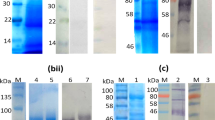Abstract
Hybridomas secreting monoclonal antibodies toNippostrongylus brasiliensis antigens were generated by hybridization of IR983F myeloma cells with spleen cells from Lou/M/Wol rats infected with living third-stage larvae. Antibodies specific either for larval or worm antigens were identified by enzyme-linked immunosorbent assays withNippostronylus brasiliensis fragments, homogenates and secretions as antigens. The results demonstrate that all antibodies which recognized larval antigens (38 antibodies) also reacted with worm surfaces. Ten antibodies were specific only for worm antigens. Ten antibodies reacted with worm homogenate, three antibodies recognized components of worm secretion and 17 antibodies combined with acetylcholinesterase. The epitope specificity was investigated by the capacity of various glycosides, aminoacids,N-acetylneuraminic acid and phosphorylcholine to inhibit the binding to worm fragments. The analysis revealed that α-methylglucoside, α-methylmannoside,N-acetylglucosamine,N-acetylgalactosamine, fucose and the amino acids leucine, phenylalanine, tyrosine, serine, tryptophan did not combine with the antigen-binding sites of the antibodies. Proline, arginine and histidine, however, displayed inhibitory effects. WithN-acetylneuraminic acid as inhibitor three groups of antibodies could be discriminated. At a concentration of 10–20 mM, phosphorylcholine was a potent inhibitor for all antibodies.
Similar content being viewed by others
References
Bazin H (1982) Production of rat monoclonal antibodies with the Lou rat non-secreting IR983F myeloma cell line. Prot Biol Fluids 29:615–618
Bohn A, König W (1982b) Generation of monoclonal DNP-specific IgM and IgE murine antibodies. On the efficacy of hybridization. Mol Immunol 19:193–199
Bohn A, König W (1982b) Generation of monoclonal murine anti-DNP IgE, IgM and IgG1 antibodies: biochemical and biological characterization. Immunology 47:297–311
Bohn A, König W (1985) Antigens of the nematodeNippostrongylus brasiliensis: Generation of monoclonal antibodies to killed parasites. Zbl Bakt Hyg (in press)
Epstein N, Miller LH, Kaushel DC, Udeinya IJ, Rener J, Howard RJ, Asofsky R, Aikawa M, Hess Rl (1981) Monoclonal antibodies against a specific surface determinant on malarial merozoite block erythrocyte invasion. J Immunol 127:212–217
Goding JW (1983) Monoclonal antibodies: principle and practice. Academic Press, New York, p 85
Haley AJ (1961) Biology of the rat nematodeNippostrongylus brasiliensis (Travassos 1914). II Preparasitic stages and development in the laboratory rat. J Parasitol 48:13–23
Jarrett EEE, Miller HRP (1982) Production and activities of IgE in the helminth infection. Prog Allergy 31:178–233
Köhler G (1981) The technique of hybridoma production. In: Lefkovits I, Pernis B (eds) Immunological methods, vol II. Academic Press, New York, p 285
Lee DL (1970) Moulting in nematodes: the formation of the adult cuticle during the final moult ofNippostrongylus brasiliensis. Tissue and cell 2:139–153
Lee DL, Bonner TP (1982) Preeze-etch studies on nematode body wall. Parasitology 84:XLIV (Astracts)
Maizels RM, Philipp M, Ogilvie BM (1982) Molecules on the surface of parasite nematodes as probes of the immune response in infection. Immunol Rev 61:109–136
Maizels RM, Meghji M, Ogilvie BM (1983) Restricted sets of parasite antigens from the surface of different stages and sexes of the nematode parasiteNippostrongylus brasiliensis. Immunol 48:107–121
Ogilvie BM, Jones VE (1971)Nippostrongylus brasiliensis: a review of immunity and the host/parasite relationship in the rat. Exp Parasitol 29:138–177
Ogilvie BM, Jones VE (1973) Immunity in the parasitic relationship between helminths and host. Prog Allergy 17:93–144
Philipp M, Rumjaneck FD (1984) Antigenic and dynamic properties of helminth surface structures. Mol Biochem Parasitol 10:245–268
Stocker JW, Heusser CH (1979) Methods for binding cells to plastic: application to a solid phase radioimmunoassay for cell surface antigens. J Immunol Methods 26:87–95
Tarrab-Hazedai R, Levi-Schaffer, F, Smolarski M, Arnon R (1984) Acetylcholinesterase fromSchistosoma mansoni. Antigenic crossreactivity withElectrophorus electricus and its functional implications. Eur J Immunol 14:205–209
Turner BM (1983) The use of alkaline-phosphatase-conjugated second antibody for the visualization of electrophoretically separated proteins recognized by monoclonal antibodies. J Immunol Methods 63:1–6
Voller A, Bidwell D, Huld G, Engvall E (1974) A microplate method of enzyme-linked immunosorbent assay and its application to malaria Bull WHO 51:209–211
Weiner DJ, Soulsby EJ (1976) Fate ofLitomosoides carinii adults transplanted into the pleural cavity or peritoneal cavity of infected and naive multimammale rats (Mastomys natalensis) J Parasitol 62:886–893
Author information
Authors and Affiliations
Rights and permissions
About this article
Cite this article
Bohn, A., König, W. Characterization of antigens of the nematodeNippostrongylus brasiliensis by monoclonal antibodies. Z. Parasitenkd. 71, 663–672 (1985). https://doi.org/10.1007/BF00925599
Accepted:
Issue Date:
DOI: https://doi.org/10.1007/BF00925599



